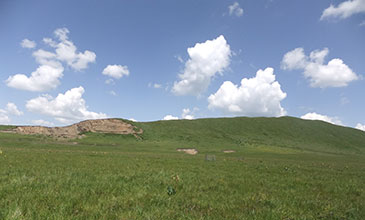The concentration of methane in the atmosphere has more than doubled over the past century. This appears to be due to many factors, including leaks from gas wells, increased rice cultivation and the prominent role of ruminant animals in our dairy and meat industry. It could also be caused partly by climate change feedbacks on natural processes, but that remains the subject of intense investigation.
The new results, published today in Nature Communications, focus on a single wetland from the Tibetan Plateau that experienced strong climate variations over the past six thousand years. They show that during relatively dry intervals, the biomass of methane-producing microorganisms decreased while methane-consuming microorganisms apparently became more efficient. The combined result would have been less methane emission to the atmosphere.
According to the project leader and Director of the Cabot Institute, Professor Rich Pancost: "What we have done is connect the dots, providing strong evidence for previous researchers’ inferences. In modern settings, methane emissions from dryer settings are generally low. Consequently, previous researchers have speculated that as the Asian monsoon became weaker over the past six thousand years, methane emissions also decreased. Here, we show that this is exactly what happened to this peatland on the Tibetan Plateau."
The authors used a combination of chemical tools to reconstruct the past changes in microbial populations. First author Yanhong Zheng said: "All organisms have cell membranes but the molecules that comprise those membranes differ, especially for microorganisms; if these molecules are preserved in soils or sediments, they act as molecular fossils – or biomarkers – for those organisms in the past. We can then quantify them and that gives insight into ancient microbial communities."
The authors focussed on archaeol, a compound that likely derives from methanogens (or methane-producing organisms) in these settings. During a dry interval from six to four thousand years ago, its concentration decreased by about 50 per cent, suggesting that the methane producing community became much smaller, probably because these organisms favour wet habitats.
Professor Pancost added: "This is only a single site, but our study has wider implication for how these systems work. The dry interval we studied arose from large scale changes in atmospheric circulation patterns, and just as past changes impacted methane emissions, so will future climate change."
The paper does not directly address whether emissions will increase in the future. However, Professor Pancost said: "A stronger monsoon – and many models indicate that monsoon intensity will increase due to global warming – could be associated with greater methane emission, but that is a tentative forecast. The real lesson of this work is how complex and interrelated biological, chemical and climate systems are, such that human-induced climate change will almost certainly have unexpected consequences."
The work was funded by European Union Marie Curie, NSFC and ERC programmes, with additional contributions from the Natural Environment Research Council, UK (NERC).
Paper
'Holocene variations in peatland methane cycling associated with the Asian summer monsoon system' by Yanhong Zheng, Joy S. Singarayer, Peng Cheng, Zhao Liu, Xuefeng Yu, Paul J. Valdes and Richard D. Pancost in Nature Communications
About the Cabot Institute
The Cabot Institute carries out fundamental and responsive research on risks and uncertainties in a changing environment. It drives new research in the interconnected areas of climate change, natural hazards, water and food security, low carbon energy, and future cities. Its research fuses rigorous statistical and numerical modelling with a deep understanding of social, environmental and engineered systems – past, present and future. It seeks to engage wider society by listening to, exploring with, and challenging our stakeholders to develop a shared response to twenty-first century challenges.
